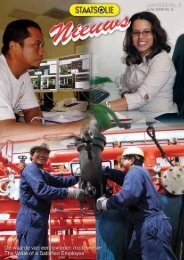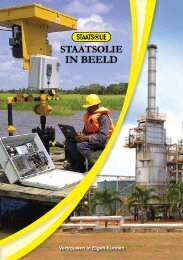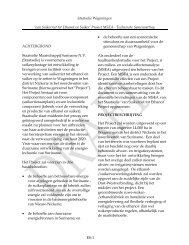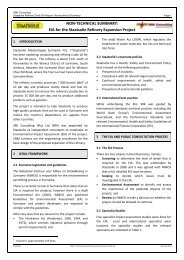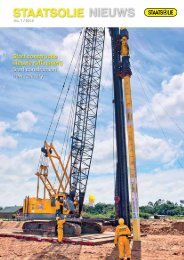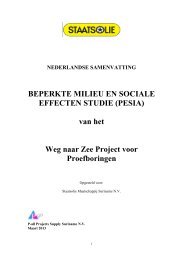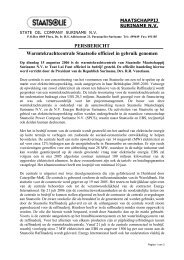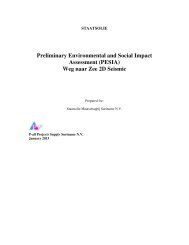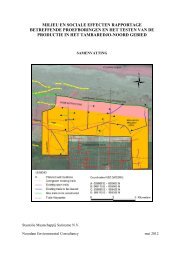concept EIA-rapport - Staatsolie
concept EIA-rapport - Staatsolie
concept EIA-rapport - Staatsolie
You also want an ePaper? Increase the reach of your titles
YUMPU automatically turns print PDFs into web optimized ePapers that Google loves.
SRK Consulting: Project No: 439414 <strong>Staatsolie</strong> Pipeline <strong>EIA</strong> – Draft <strong>EIA</strong> Report Page 72<br />
With the implementation of mitigation measures listed below, the risks of substantial sub-surface<br />
contamination or aquifer contamination following a leak is considered minimal.<br />
Pollution of surface water and areas<br />
The risk of any spill reaching the surface is higher in areas where the pipeline lies above ground or<br />
shallow underground, as there is little or no overlying material that could prevent or slow the rise of<br />
fuel and exert counter pressure on the pipeline. However, shallow underground pipeline sections are<br />
expected to be specially protected by a plate inserted above them and thicker pipeline walls.<br />
The majority of the pipeline lies embedded in a clay layer up to 30 m underneath the Suriname<br />
River, and is further encased by the bentonite drilling mud that remains in the drill hole and congeals.<br />
The clay layer and congealed bentonite mud are relatively impermeable, and any leaks, particularly<br />
gasoline or diesel, would be expected to only slowly leak upwards through fissures in the ground.<br />
Leakage that occurs within a compact clay layer would thus be very localised 38 . These sections of<br />
the pipelines are also well protected from external interference, and the risk of an incident and/or the<br />
leaked material causing widespread pollution is lower.<br />
Based on the calculations undertaken in the QRA to evaluate pipeline risks, the maximum individual<br />
risk is low, i.e. generally well below 1x10 -6 per year risk of a fatality (meaning there is a one in a<br />
million chance of a fatality per year). The highest risk was calculated for the areas where pipeline<br />
sections HDD2 and HDD3 connect and the SOL and OGANE offtakes, where the fatality risk was<br />
calculated at a still very low 1.6x10 -6 per year. Based on international guidelines, this risk is<br />
considered to be acceptable without any further mitigation.<br />
The potential impact of an incident depends on the type of fuel that is spilled and the environment in<br />
which the spill occurs, as described in Table 6-12.<br />
Table 6-12: Potential impacts from pipeline leaks in various environments<br />
Product<br />
Location<br />
Suriname<br />
River<br />
LPG spill Diesel/gasoline spill<br />
An LPG spill is likely to reach the surface<br />
(river bed) more quickly, as the LPG is<br />
much lighter than its surrounding<br />
material.<br />
It is expected that an LPG incident in the<br />
Suriname River would have no long-term<br />
environmental damage as the gas<br />
evaporates rapidly with little or no impact<br />
to surroundings.<br />
The main hazard associated with the<br />
LPG pipeline is loss of containment<br />
resulting in a gas release, which could be<br />
ignited by a vessel in the vicinity. The<br />
resultant fire could engulf the vessel and<br />
cause fatalities to the crew and<br />
passengers on board, either directly due<br />
to the fire or due to the vessel sinking (in<br />
the worst case).<br />
A gasoline or diesel spill, if / once it has worked its<br />
way up from the pipeline, forms a layer on the<br />
water surface and therefore has a higher potential<br />
impact to the bio-physical environment than LPG.<br />
Diesel and gasoline will be transported with the<br />
river flow (ebb and flow conditions), with the<br />
influence of wind drag.<br />
Evaporation occurs immediately after release. As<br />
the surface slick spreads, more of the diesel and<br />
gasoline are exposed to the atmosphere, causing<br />
the evaporation rate to increase. Since gasoline is<br />
considerably more volatile, it would evaporate<br />
much more readily than diesel. Evaporation is the<br />
most significant physical-chemical process<br />
causing the reduction in the spill volume.<br />
Diesel and gasoline plumes may reach the<br />
riverbanks, with deposition along the shoreline, to<br />
be later re-entrained into the river current.<br />
Some of the suspended oil droplets may also sink<br />
to the riverbed. The oil deposited on the channel<br />
bottom may be transported laterally or<br />
resuspended, or undergo further biological or<br />
physical-chemical reaction.<br />
38 As opposed to leakage within a sandy substrate, in which the fuel could easily spread over a large area before reaching the<br />
river, resulting in extensive sub-surface contamination<br />
REUT/DALC 439414_<strong>Staatsolie</strong>Pipeline<strong>EIA</strong>_Draft <strong>EIA</strong> Report_Final June 2012




